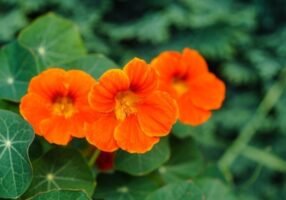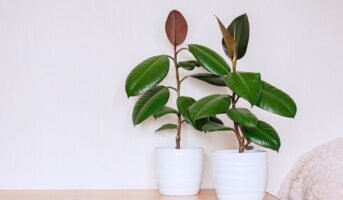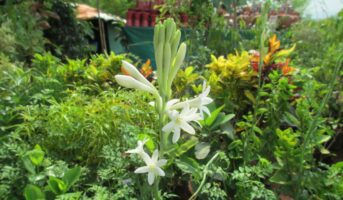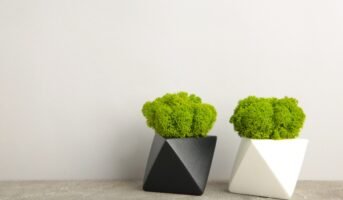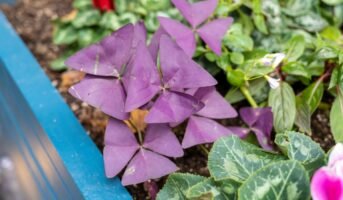Blue flowers are a beautiful addition to any garden or floral arrangement. With their calming and soothing hues, blue flowers evoke feelings of serenity and peace. Whether you prefer the soft, delicate shade of periwinkle or the bold, striking blue of delphiniums, there is a blue flower for every style and preference. Many popular blue flower options include hydrangeas, lavender, forget-me-nots, and irises. Blue flowers also play well with other colours, making them versatile for use in mixed bouquets and garden beds.
Blue flowers: Varieties
Here is a list of some of the most popular and beautiful blue flowers.
Beautiful blue flowers #1: Blue Hydrangea

Source: Pinterest
The blue hydrangea is an incredibly stunning flower that comes in a range of shades, from vivid blues to more subtle shades like powder or sky blue. The shade of the blue varies depending on the alkalinity of the soil. When given as a gift, blue hydrangeas convey a heartfelt and strong feeling of love. In a garden, these flowers can create a beautiful and serene atmosphere and are perfect for adding a touch of blue to any outdoor space.
Beautiful blue flowers #2: Delphinium flowers
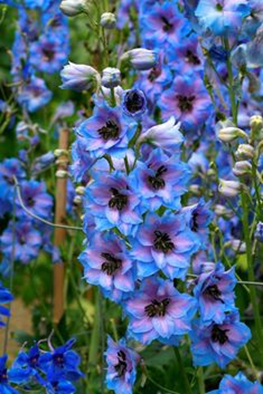
Source: Pinterest
The delphinium is a flower that comes in some of the truest shades of blue. With its dolphin-like shape, the delphinium symbolises fun, levity, ardent attachment, and bigheartedness in the language of flowers. These flowers grow tall and are perfect for adding height and structure to a garden. They are also great for cutting and bringing inside to brighten up a room.
Beautiful blue flowers #3: Grape Hyacinth
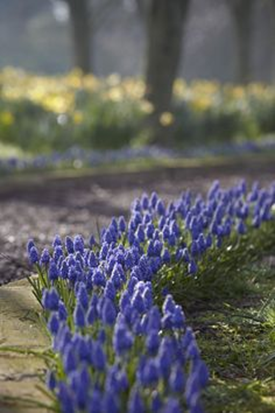
Source: Pinterest
The grape hyacinth is a beautiful bulb-shaped flower that grows in clusters in mid-spring. They come in a range of colours, including purple, white, and yellow. Grape hyacinth is associated with rebirth and represents games, sports, rashness, and playful joy. The grape hyacinth symbolises constancy and trust, making it a great gift for someone you consider a constant in your life.
Beautiful blue flowers #4: Clematis flowers
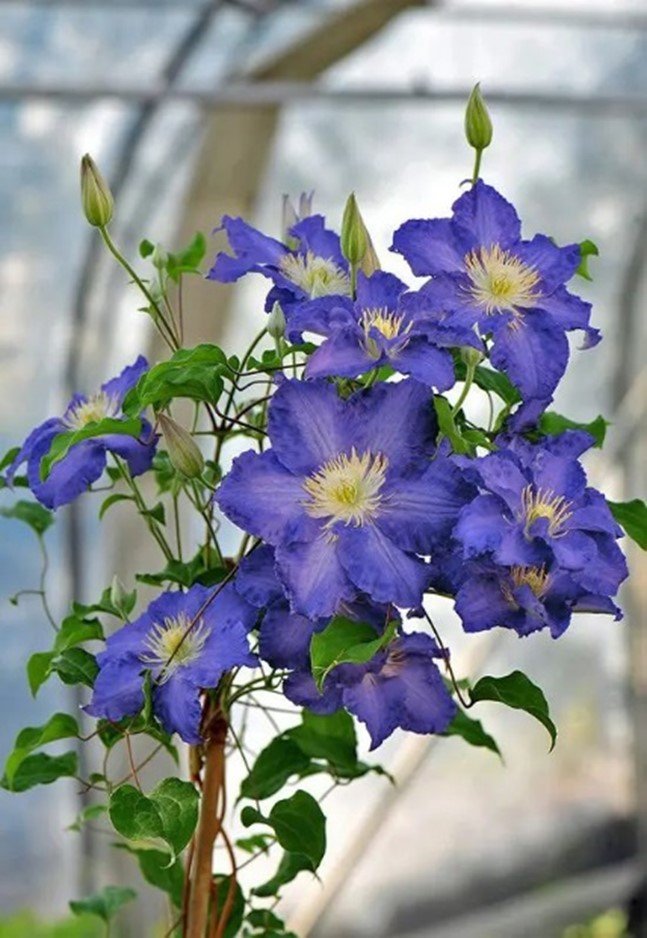
Source: Pinterest
Clematis is a flowering climber plant that is commonly used for ornamental purposes. The true blue varieties of this flower include ‘Crystal Fountain’, ‘Ice Blue’, and ‘Arbella’. The meaning of clematis is mental prowess, and the blue clematis signifies faithfulness, ingenuity, and courage. Clematis is perfect for adding some colour to a garden wall or trellis.
Beautiful blue flowers #5: Dandelion flowers

Source: Pinterest
Dandelion flowers are associated with love, affection, desire, and sympathy, while the blue dandelion represents faithfulness, happiness, and tranquillity. This popular flower is found in folklore and legends and has been symbolic in a variety of cultures. Dandelions are native to Europe and Asia but are now widely available all over the world. These flowers are perfect for adding a pop of blue to a garden or for giving as a gift to show someone how much you care.
Blue flowers: Care tips
Here are some useful tips to help you maintain different varieties of blue flowers in your home garden.
Blue flowers: Light and soil requirements
The light and soil requirements of blue flowers will vary depending on the specific species. Some blue flowers, like forget-me-nots, prefer partial shade, while others, like delphiniums, thrive in full sun. Most blue flowers prefer well-drained soil with a slightly acidic pH, but again, the specific requirements will vary by species.
Blue flowers: Watering and fertilising
Blue flowers also have differing water and fertiliser requirements. In general, blue flowers prefer evenly moist soil but are not waterlogged. You can add organic matter, like compost or aged manure, to the soil to provide the necessary nutrients for your blue flowers. It is also recommended to fertilise your blue flowers every four to six weeks during the growing season to promote healthy growth.
Blue flowers: Pests and diseases
Like all plants, blue flowers are susceptible to a variety of pests and diseases. Common pests include aphids, Japanese beetles, and slugs, while common diseases include powdery mildew, botrytis, and verticillium wilt. Proper care, such as proper watering and adequate air circulation, can help prevent these issues.
Blue flowers: Uses
Blue flowers have a variety of uses. Here are five major uses for blue flowers:
Meaningful bouquets: Blue flowers for every occasion
Blue flowers are perfect for adding depth and meaning to floral arrangements. They are often associated with peace, tranquillity, and harmony, making them a great choice for expressing sympathy or offering condolences. For celebrations like weddings and baby showers, blue flowers can add a pop of colour and elegance.
Gorgeous garden additions: Planting blue flowers
Planting blue flowers in your garden can add a serene and calming effect. They complement other flower colours and can make your garden stand out. Blue flowers like forget-me-nots, delphiniums, and hydrangeas are perfect for creating a stunning garden design.
Blue blooms: The prettiest flowers for home decor
Blue flowers are perfect for enhancing your home decor. Their natural beauty and calming colour make them ideal for creating a serene and peaceful atmosphere. Blue flowers like cornflowers, bluebells, and blue poppies are the prettiest options to consider. They can be displayed in a vase, used as a centrepiece, or placed on a windowsill to brighten up any room in your home.
Captivating colour: Blue flowers for landscaping
Landscaping with blue flowers can add a touch of charm and beauty to your outdoor space. Blue flowers like salvia, cornflowers, and lobelias can create a stunning visual impact when planted in masses. They also attract pollinators like bees and butterflies, making them an eco-friendly addition to your garden.
Something blue: Stunning blue flowers for weddings
Blue flowers like blue delphiniums, blue hydrangeas, and bluebells are popular choices for weddings as they represent loyalty, fidelity, and love. They can be used as centrepieces, boutonnieres, or in the bridal bouquet. The blue hues of these flowers also make them a perfect “something blue” for the bride.
FAQs
Is a true blue rose real?
A true blue rose does not exist in nature. Alternatively, you can buy a genetically modified blue rose or dye a white rose blue.
What is the reason for the rarity of blue flowers?
It is very rare to find blue pigments in flowers, unlike other colours in nature.
Housing News Desk is the news desk of leading online real estate portal, Housing.com. Housing News Desk focuses on a variety of topics such as real estate laws, taxes, current news, property trends, home loans, rentals, décor, green homes, home improvement, etc. The main objective of the news desk, is to cover the real estate sector from the perspective of providing information that is useful to the end-user.
Facebook: https://www.facebook.com/housing.com/
Twitter: https://twitter.com/Housing
Email: [email protected]

